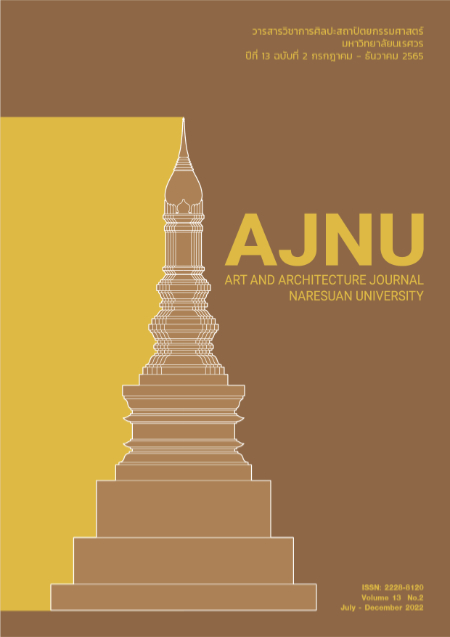The development of watercolors from Annatto seeds for using in the creation of artworks
Main Article Content
Abstract
This article regarding the development of watercolors from Annatto seeds for using in the creation of artworks aims to 1. develop the watercolors from Annatto seeds for using in the creation of artworks and 2. compare the color values from Annatto seeds with the 3 formulas from the research. These are including the first formula from the mixture of Annatto powder, water, as well as ethanol, the second formula from the mixture of Annatto powder, water, Arabic gum, as well as honey, and third formula from the mixture of Annatto powder, water, glycerin, Arabic gum, as well as honey. Then, painting all formulas with different collecting time (immediate, 3-day, and 7-day collection) on the different types of paper and measuring by colorimeter with
L a* b* color value. It is found that the mixture of the first formula on 300-gram paper performs +a value in
red zone with the highest level at 37.2 and shows the high saturation in red zone. In contrast, the mixture of second formula on 200-gram paper perform +a value in red zone with the lowest level at 15.10. For the highest L value, the second formula with 7-day collection performs on 200-gram paper at 81.00 and 300-gram paper at 80.10. For the lowest reduction of +a value, the third formula from the mixture of Annatto powder, water, glycerin, Arabic gum, as well as honey performs on 200-gram paper with the differences at 9.10 and 300-gram paper at 9.30. Meanwhile, the highest reduction of +a value in red zone belongs to the second formula from the mixture of Annatto powder, water, Arabic gum, as well as honey. This performs on 200-gram paper with the differences at 17.90 and 300-gram paper at 11.70. For the lowest L value (shadiness) of color, the third formula with 7-day collection performs on 300-gram paper at 11.00. Thus, the mixtures with glycerin provide the +a value in red zone and the lowest L value. Besides, the measurement of color from the first formula with 7-day collection painted on the paper provides the highest + b value in yellow zone at 42.70.
Article Details

This work is licensed under a Creative Commons Attribution-NonCommercial-NoDerivatives 4.0 International License.
References
Barrozo, M. A. S., Santos, K. G., & Cunha, F. G. (2013). Mechanical extraction of natural dye extract from Bixa
orellana seeds in spouted bed. Industrial Crops and Products, 45, 279-282.
Chanunpanich, N., Pinsem, W., Boonyapalanant, B., and Byun, H. (2009). Purification of Glycerine from Biodiesel Production. The Journal of KMUTNB, 19 (1), 66-72.
Hoitongdaeng, P. (2005). Natural Dye Plants. Bangkok: P. Press Co., Ltd.
Kado, H., Wongpichet, S., and Ketpanyapong, W. (2015). Effect of Pigment from Annatto Seed in Layer Diats
onYolk Color. Journal of Yala Rajabhat University, 10(1), 17- 27.
Kongtun Janphuk, S. (2013). Development of Glycerin Clear Natural Herbal Soap Bar with Herbal Extracts
against Antibacterial Activity on Human Skin. Agricultural Science Journal, 44 (2), 509-512.
Narongdecha, W. (2019). Natural Color Extraction for Painting. Asia-Pacific Journal of Science and
Technology, 24(3), 1-11.
Noiduang, P. (2012). Gum and Mucilage from Plants. Journal of Food Technology, Siam University,
(1), 1-10.
Sathaporn, C. (2012). Creating Printmaking Artworks with Natural Dyes from Plants in Nakhon Si Thammarat Province. Journal of Fine Arts, 3(1), 267-301.
Shahid-ul-Islam, L. J., and Mohammad, F. (2016). Phytochemistry, biological activities and potential of
annatto in natural colorant production for industrial applications–A review. Journal of Advanced
Research, 7(3), 499-514.
Sittinoppan, P., Kaentubtim, P., and Panbumrung, P. (2014). The development of tie-dyed prototype with natural
dyes. Journal of Western Rajabhat University, 9(1), 81- 89.
Siva, R., Doss, F. P., Kundu, K., Satyanarayana, V. S. V., and Kumar, V. (2010). Molecular characterization of
bixinAn important industrial product. Industrial Crops and Products, 32(1), 48-53.
Tanganurat, P., Pojanakorngoson, P., Busayasoros, N., and Sawatthum, A. (2015). Antibacterial Activity of Honey. Agricultural Science Journal, 46(3), 325-328.
Tangjitwiboonkun, S. and Chaiprasart, P. (2013) . Effect of gum Arabic coatings on postharvest quality of ‘long lab
lae’ durian fruits at low temperature storage. Khon Kaen Agriculture Journal, 42(3), 51-26.
Vilar, D. D. A., Vilar, M. S. D. A., Moura, T. F. A. D. L. E., Raffin, F. N., Oliveira, M. R. D., Franco, C. F. D. O.,
Athayde-Filho, P. F. D., Diniz, M. D. F. F. M., and Barbosa-Filho, J. M. (23 June 2014). Traditional uses,
chemical
constituents, and biological activities of Bixa orellana L.: a review. The Scientific World Journal.
Retrieved November 28, 2021, from https://www.hindawi.com/journals/tswj/2014/857292/
Wongsangthain, P. (2020). A Study of Silk Yarn Dyeing with Natural Dye from Annatto Tree Seeds. TNI Journal of Engineering and Technology, 8(2), 1-7.

